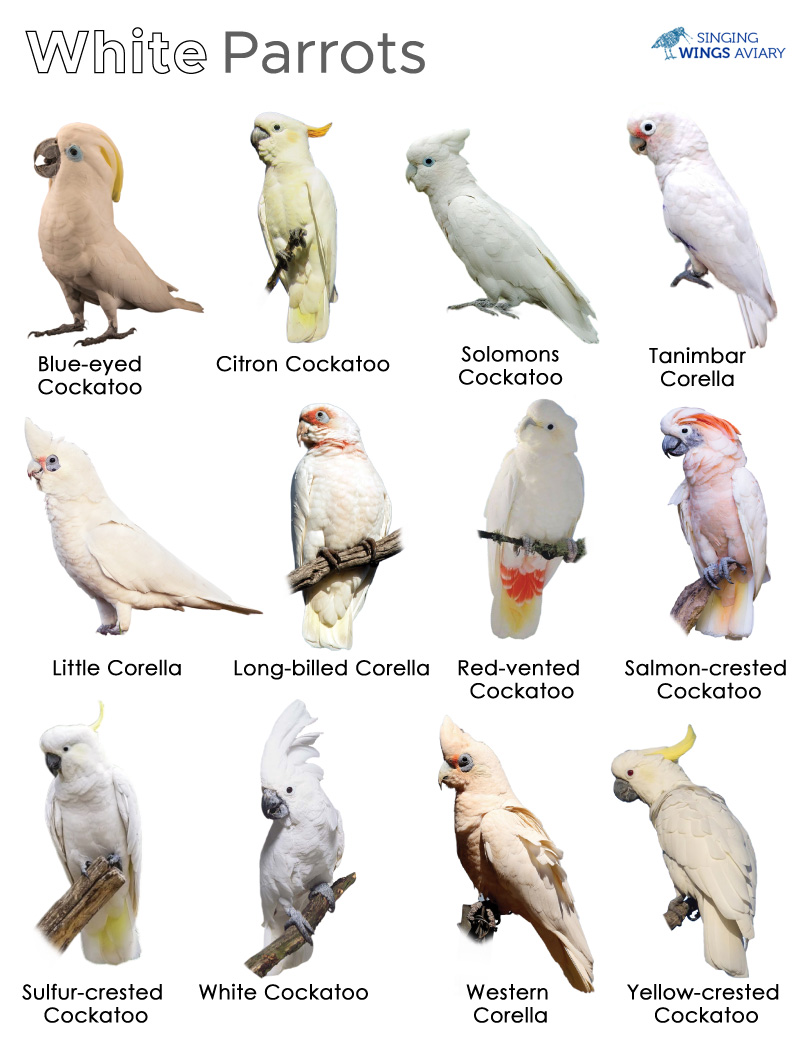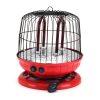Among the most popular white birds kept as pets are the Yellow-crested Cockatoo, Goffin’s Cockatoo, and Umbrella Cockatoo. These birds are not only admired for their stunning white feathers but are also cherished for their engaging personalities and affectionate natures.
List of Pet Parrots With Naturally White Plumage
All of the white birds kept as pets are parrots, specifically those belonging to the cockatoo family.
| Name | Length (in) | Weight (oz) | Where They Are From |
|---|---|---|---|
| Blue-eyed Cockatoo | 18-20 | 17-20 | New Britain, Papua New Guinea |
| Citron Cockatoo | 12-13 | 12-15 | Sumba, Indonesia |
| Solomons Cockatoo | 10-12 | 14-17 | Solomon Islands |
| Tanimbar Corella | 10-12 | 9-11 | Tanimbar Islands, Indonesia |
| Little Corella | 14-16 | 13-22 | Australia and southern New Guinea |
| Long-billed Corella | 14-16 | 19-20 | Victoria and southeastern New South Wales in Australia |
| Red-vented Cockatoo | 10-12 | 10-12 | The Philippines |
| Salmon-crested Cockatoo | 18-20 | 29-30 | Seram Archipelago, Indonesia |
| Sulfur-crested Cockatoo | 17-22 | 28-34 | Australia, New Guinea, and parts of Indonesia |
| White Cockatoo | 17-18 | 14-28 | Indonesia |
| Western Corella | 16-19 | 19-29 | South-western Australia |
| Yellow-crested Cockatoo | 11-13 | 10-12 | East Timor and Indonesia’s islands of Sulawesi and the Lesser Sundas |
There are other cockatoos, like the pink cockatoo and the galah, that have partial white plumage mixed with feathers of other colors, such as pink and red.
Pet Birds With White Morphs
Some birds have white morphs, which result from random genetic mutations or selective breeding, even though they are not naturally white. For example, the White-faced Cockatiel is a color mutation where the usual orange cheek patches are absent, resulting in a distinctive white appearance.
- White Australian Zebra Finch
- White Budgerigar
- White-faced Cockatiel
- White Domestic Canary
- White Society Finch
- White Indian Ringneck Parakeet
- White Fischer’s Lovebird
How Do White Parrots Get Their Color
Their white plumage is typically due to low levels of melanin, a pigment that colors their feathers. It is important to note that this white coloration is different from albinism, a condition that results in a complete lack of pigment in the eyes and skin, which can affect vision. White birds simply have less melanin, resulting in striking white feathers without impacting their vision or overall health.






